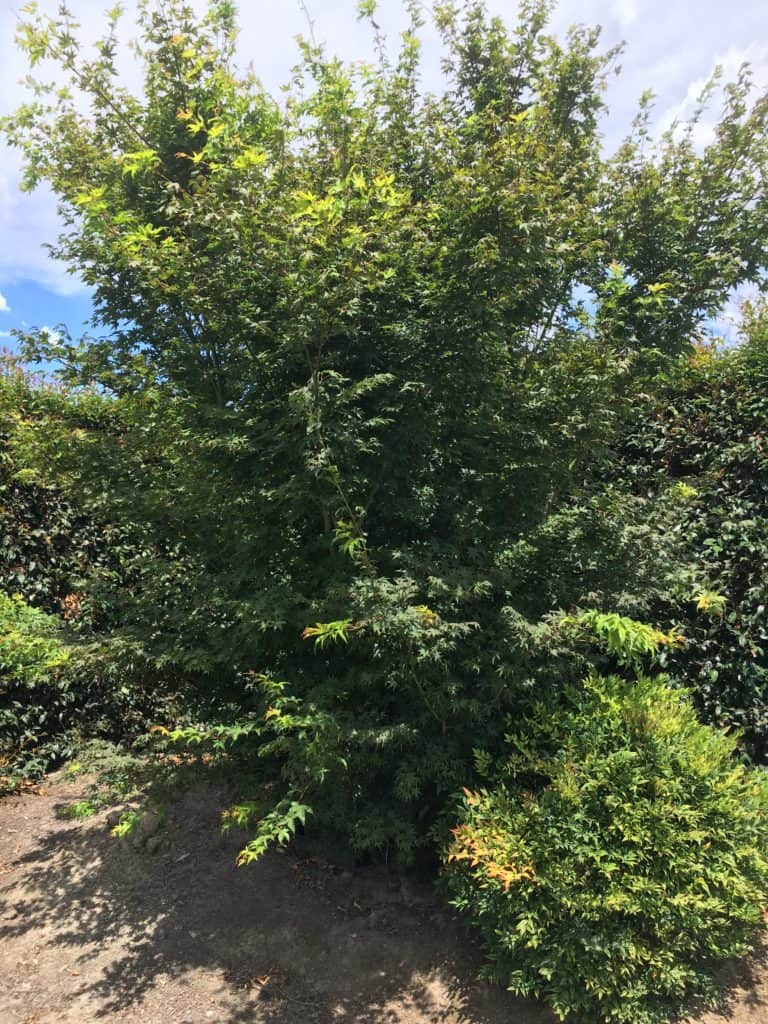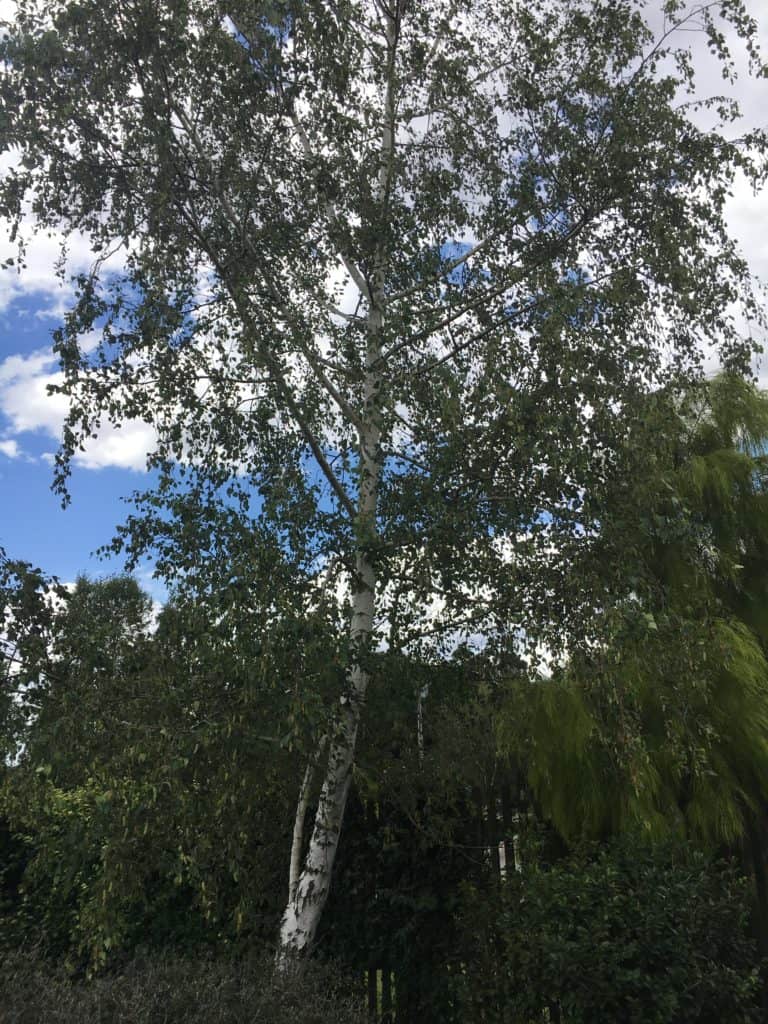People often ask us what is the best trees to provide shade during the warmer months, while allowing light in during winter? Here we can answer that question. Keep in mind we live in South-Eastern Australia so these are our choices for our climate.
Obviously the tree must be deciduous, that simply means it drops it’s leaves at certain times of the year, almost always autumn into winter. It should have a good strong habit, not be known to drop branches.
Some people will want a shade tree in the yard where the kiddos play. Others will want shade closer to the house to shield from the heat of summer, but allowing the sun in winter. Some will want trees that grow really huge! While others need a more modest tree for a small suburban yard.
With all those possibilities in mind here’s our personal favourites.
Maple (Acer)
Maples come in many different shapes and sizes. They are quite fast growing when young. There are so many different types of maples that there is bound to be one that suits your needs. Here are the most common types used in our area.
Sugar maple (acer saccharinum)
This maple is famous for being the leaf displayed on the Canadian flag and being the source of maple syrup. It’s a very large tree once established so not suitable for the small suburban garden. But if you’ve got an acre or more this could be a great choice for you!
It grows to a height of 25m with a spread of up to 10m wide. It’s a moderate to slow growing maple so don’t expect that kind of size for quite some time. But an old established sugar maple in the middle of a well maintained lawn is quite the sight! If you have the room and know your going to be living in your current house for the long term, plant one now! While it’s establishing plant some faster growing trees.
The autumn colours are spectacular in shades of yellow, red and orange. It does best in cold climates
JAPANESE MAPLE (ACER PALMATUM)
Japanese maples are much smaller growers but grow nice and fast. We use Japanese maples extensively in our garden. They have a nice branching habit that provides a wonderful umbrella like canopy.
They’re a great choice for smaller suburban gardens where one can form the centrepiece of a garden. But they are also great in larger gardens where small to large groves of them can be planted providing and abundance of shade.
They respond excellent to pruning! We have a row of them along our north facing verandah. During summer they provide that much needed sun shield and then in winter they allow the sun to beam into the house. Very easy to maintain, we give them a prune every winter to keep them below the house gutters.
We have personally used Japanese maples grown from seeds as we planted lots and they are much cheaper than named cultivars. However the next one we purchase will be a coral bark maple (acer palmatum “Sango Kaku”) The bark is the most vibrant red producing interest even when the tree has no leaves.
The autumn colours on the Japanese maples are also quite striking in yellows and oranges.
 Young Japanese maple in our garden
Young Japanese maple in our garden
Lipstick Maple (Acer rubrum)
Lipstick maples aren’t as big as the sugar maple but are generally larger than Japanese maples. Reasonably fast growing in our area, they seem to grow almost a metre a year when young.
They mature to a height of around 12m with a great shade producing canopy of 7 metres. Probably best suited to larger blocks of land. It can look great as a stand alone tree, but looks absolutely spectacular as an avenue along a fence line or driveway.
The most popular variety in our area would have to be “October Glory” famous for being in the courtyard at parliament house. The autumn colour is truly breathtaking going from a dark pinky-red into and organge-red. The display is made all the more spectacular by the unusually long period the leaves hold onto the tree for.
Birch (Betula)
Birch are another very popular deciduous tree in our local area. They are a beautiful tree and quite fast growing. We have 3 favourite birches we see doing well in our region.
Silver birch (Betula pendula)
Silver birch is the most commonly available of the birch trees. It gets it’s name from the silver-white trunk. The delicate foliage has a drooping habit.
Silver birch grow to a mature height of approximately 10m (33ft) with a spread of 6m (20ft). Keep in mind that is the mature demensions. Silver birch grows upright very quickly but will take a while to develop a large spreading canopy. So if you require summerr shade quickly consider planting a small grove of 3 or more trees.
Well suited to both small and large yards. In a small yard can easily be pruned after the leaves have fallen off. Also when cluster planted, they will not tend to grow as large.
Autumn sends the leaves yellow, not quite as striking in it’s autumn colours as maples are, but the beautiful white trunk more than makes up for that.
Being quite common you should be able to pick them up at a good size for a very reasonable price.
 Young silver birch in our garden
Young silver birch in our garden
Cut-leaf birch or Swedish birch (Betula pendula ‘Dalecarlica’)
Cut leaf birch is another type of silver birch. Once again the trunk is a beautiful white. This particular birch is the national tree of Sweden. The difference between it and silver birch is the leaves, which are very serated, having prominant points.
They tend to grow at a similar rate to silver birch and a mature tree should grow to about 11m (36ft) with a width of 6m (20ft).
As with the silver birch the canopy will take longer to develop, but once again planting in groves can provide that much needed summer shade faster.
The leaves also turn yellow in autumn.
While not quite as common as straight silver birch they should still be readily available at a reasonable price.
Himalayan birch (Betula utilis)
Himalayan birch is said to have the whitest of trunks of all the birches. That makes it highly prized. The leaves are dark green and serated, but not quite to the extent of the cut-leaf birch.
They grow to the same size and width of silver birch. My uncle has used these along the side of his house to provide shade during summer whilst allowing the light in during winter. He keeps the branches pruned to stop the leaves falling into the guttering.
The avenue of beautiful white trunks is very striking indeed. Like the above birches the leaves turn yellow in autumn before falling off in winter.
Not as common, you might need to pay a little more for their uniqueness.
Oak (Quercus)
Oaks are beautiful large trees known for their iconic acorns. Here are 3 of our favourites for providing summer shade.
Fun fact! Most oaks are incredible long lived and as such will not produce acorns in their first 40 years of life!
English oak (Quercus robur)
English oak is a large stately tree. It is incredibly long lived and will not reach full maturity in your or my lifetime. English oaks form a very wide open canopy allowing dappled light to penetrate.
Because it creates such a broad canopy the first branches are often quite low to the ground and incredibly strong (as strong as an oak) this makes it a great climbing tree!
It can exceed 20m (65ft) and is therefore only suited to very large gardens. It can look incredible in the middle of a well maintained lawn. Whilst classified as a slow grower due to it’s largeness and longevity, oaks will grow quite fast when young.
There is a well established english oak at our kids school and it provides a huge shadow for the kids to escape the hot Aussie sun. The kids also love collecting the acorns when they drop to the ground.
So even though you might not get to reap the full benefits of the shade which this beautiful tree provides, over time someone will be very grateful.
Red oak tree (quercus rubra)
Red oak is grown for the striking red autumn foliage. The colder the climate the better for producing vibrant shades. Like all oaks it’s long living, however, red oak seems to grow faster than english oak.
It tends to grow a solid strong trunk with the canopy rounding with age. Not as wide as english oak, spreading to about 9m (30ft) whilst still reaching heights of 20m (65ft) or more.
Again not suited to smaller gardens.
Pin oak (Quercus palustris)
Pin oak is the fastest growing of our favourite oak trees. The lower branches of the tree will droop down, the middle branches are parallel to the ground whilst the upper branches point to the sky.
Pin oak has a conical shape and matures to a height of 15m (50ft) with an 8m (26ft) spread. Autumn colour is a Brown/Red. Sometimes during milder winters the leaves can take quite a long time to fall off.
Like the above oaks, they need a large yard or acreage to be allowed to reach it’s full potential.
Ash (Fraxinus)
There are 2 popular choices here in Victoria when it comes to Ash trees grown for shade. The claret ash and golden ash have been very popular for many years.
Claret Ash (Fraxinus angustifolia raywood)
Apparently the claret ash was discovered in a nursery in South-Australia. It is a beautiful hardy tree. Most say it’s the most striking ash of them all. Leaves are a deep dark green during the warmer months. During autumn is when the real show starts with leaves turning a striking plum-purple colour.
Fast growing up to 1.5m (5ft) per year. It forms a beautiful rounded shape making it perfect for casting a big shadow. Mature height is 15m (50ft) with a 9m (30ft) spread.
Best suited to large gardens, nature strips, etc.
Golden Ash (Fraxinus excelsior Aurea)
Golden ash is also a beautiful hardy tree. In spring and summer the foliage is a green/lime colour. During Autumn the leaves become a golden-yellow. It has quite a deep root system making it able to withstand warm conditions. The bark is also yellow making it quite obvious why it’s called a golden ash.
A smaller grower than claret ash, Golden ash reaches a more manageable 7m (23ft) high by 7m (23ft) wide. Being smaller it doesn’t grow as fast as claret ash. Expect a more modest 50-60cm (3ft) growth per year.
Because of the strong root systems avoid planting near houses, pipe work, etc.
Jacaranda
There are almost 50 different types of jacaranda. The one we grow here in Australia is Jacaranda mimosifolia which is actually native to a hot and arid area of Argentina. I know right! Most people think they are an Australian native, they are so common in suburban Australia.
The tree is known for its striking lilac-blue blooms that appear in abundance during summer. Here in our climate their flowering almost always coincides with the holiday period. It’s like purple snow! I also find the delicate fern like foliage very appealing.
Fairly fast growing it will mature to a height of 10m (33ft) with an 8m (26ft) spread, at least according to most plant labels. Here in West gippsland it’s more common to see them only reaching 3-5m (10-16ft). I would feel more than comfortable having one in the backyard or front yard of a suburban garden.
The leaves turn yellow in winter and fall of shortly thereafter.
So there you have our favourite trees for summer shade and winter light. In conclusion, if looking for a deciduous shade tree for a smaller yard or garden, stick with maples, birches or jacaranda.
Obviously larger gardens can have any or all on this list, but for big beautiful deciduous shade trees, do yourself a favour and select an ash or oak tree to incorporate into your garden.
Thanks for reading. Happy Planting 🙂
